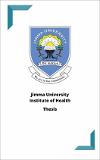IPHC-E Repository System
Prevalence and associated factors of common mental illnesses among persons of working age in Hadiya zone, SNNPR
- Home
- →
- Universities
- →
- Jimma University, Institute of Health
- →
- JU Theses and Dissertations
- →
- View Item
JavaScript is disabled for your browser. Some features of this site may not work without it.
| dc.contributor.author | Markos, Yilma | |
| dc.date.accessioned | 2021-04-28T07:57:21Z | |
| dc.date.available | 2021-04-28T07:57:21Z | |
| dc.date.issued | 2016-06-30 | |
| dc.identifier.uri | http://repository.iifphc.org/handle/123456789/1283 | |
| dc.identifier.uri | https://repository.ju.edu.et/handle/123456789/3207 | |
| dc.description.abstract | Background: Mental illnesses are public health problems in the world and more common in low income countries. It causes direct mortality, morbidity and significant risk factor for adverse health out comes. In Ethiopia, among every five persons, an individual is affected by common mental illness. Objectives: To assess the prevalence and associated factors of common mental illnesses among persons of working age in Hadiya zone, south of Ethiopia. Methods: A community based cross sectional study was conducted in Hadiya zone from February to March 2016 on a total 722 sample respondents, whose age ranges from 15 to 64 years. The study subjects were selected by two stages stratified sampling technique. Data was collected on individual risk factors common mental illnesses (CMIs), using-interviewers administered questionnaire. The data was entered in to EPI Data version 3.1 and exported to SPSS version 20 statistical software for analysis. Univariate, bivariate and multivariate analyses were done. Results: The prevalence of CMIs was found to be 46.1% (95% CI: 42.7, 49.7%). The age from 55 to above years were almost 46% less likely develops CMIs than from age 35 to 54 years (AOR=0.54, CI: 0.36, 0.804). Those respondents having single marital status 52.6% less likely develops CMIs than ever married (AOR=0.474, CI: 0.307, 0.734). Those respondents were having pervious history of chronic medical illness 1.9 times more likely develops CMIs (AOR=1.9, CI: 1.109, 3.279).The respondents were having small family size , 1.9 times more likely develops CMIs than large family size (AOR=1.9, CI: 1.206, 2.846). Those were having pervious history of khat chewing 4.5 times more likely develops CMIs non chewer (AOR=4.5, CI: 3.066, 6.603) and the respondents having stressful life events like major financial crisis 2.9 times more likely develops CMIs than those have non finical crisis (AOR=2.9, CI: 2.007, 3.978). Conclusions: This study confirmed that CMIs are major public health problems in Hadiya zone with high prevalence, due to using the different cut off point in urban and rural community and they are majority groups. Common in lower age, small family size, pervious family history of chronic medical illness, having single martial status, pervious history of khat chewer and those having major financial crisis were significantly associated with CMIs. | |
| dc.language.iso | English | |
| dc.publisher | Jimma University | |
| dc.subject | Mental health & psychosocial health services | |
| dc.title | Prevalence and associated factors of common mental illnesses among persons of working age in Hadiya zone, SNNPR | |
| dc.type | Thesis |
